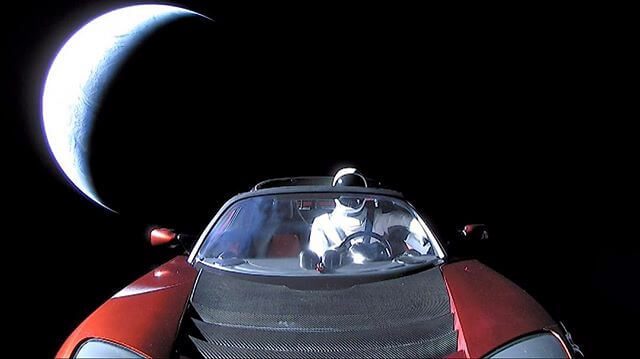Guest writer Morten Pahle gives his views about Elon Musk’s recent stunt on the first flight of the Falcon Heavy and wonders if there is not more to come?
The maiden launch of the Falcon Heavy (aka Falcon 9 Heavy) was a great achievement and has hopefully inspired many young – and possibly some not so young – budding engineers to dream for the stars and take up science and engineering studies. Replacing the traditional heavily instrumented mass dummy with a Tesla roadster demonstrates that the corporate world can still have fun. Adding to that the David Bowie soundtrack, the live cameras, references to Asimov and the Hitchhiker’s Guide to the Galaxy and a plethora of other hidden messages and meanings, inside jokes etc. and the whole project is simply very cool. If the roadster is indeed ever salvaged by an alien intelligence, it will add a dimension and understanding of the human race not quite present on the Voyager Golden Records.
And it also establishes, if it were still necessary – and using the jargon from the Hitchhiker’s series – that Elon is a hoopy frood who really knows where his towel is.

Never look back: Starman in his Tesla Roadstar with the Earth rapidly diminishing behind him. Courtesy: SpaceX
And yet…
After a couple of hours the live camera feed ended and we are made to believe that the roadster, with its Spaceman as well as the entire upper stage of the launcher, will now orbit the sun forever, in an orbit which will take it beyond Mars orbit, returning to the neighbourhood of Earth’s orbit every 17 months. Drifting, inertly, like a random peace of space junk or asteroid. And, by Elon’s standards, that’s just too simple and easy.
The maiden flight of the Falcon Heavy proved several things. Apart from the maiden flight itself, it proved amongst others the quasi simultaneous return of three boosters (two of which were returned intact) and the ability of the upper stage to achieve an interplanetary orbit towards Mars.
What it did not prove was SpaceX ability to manufacture an interplanetary stage which could survive the long drift through interplanetary space and be alive to reignite into a potential Mars orbit insertion. But maybe it might…
In Mars orbit, solar arrays need to be larger than in earth orbit to provide the same power output – a properly aligned array only produces about 40W per square meter. If you do not align the array, but, for instance, mount a fixed array on the conical launch adapter, efficiency drops significantly. But as the stack rotates, it would still be able to intermittently charge a battery. This, in turn, could be used to give occasional communication capability and potential survival thermal control for some limited avionics. A shaped parabolic reflector would occasionally allow a link to be established back home. The entire assembly would neither be voluminous nor heavy.
The released photos of the Roadster under the fairing do not show anything like this, but that does not mean it was not there. And the wedge shaped structure between the adapter cone and the Roadster can hide a whole host of kit – none of which would have been visible to any of the cameras as they showcased the mesmerising scene of the Roadster speeding past the Earth in interplanetary space.
Would it have been possible to make the Roadster/upper stage capable to do more than it has done? Is there any chance that there is propellant remaining which could be used for a later burn and possibly a simulated Mars Orbit insertion manoeuvre? I could not do it. But I am not Elon Musk. Compared to building the Falcon Heavy, it would almost be easy.
So should we be surprised if, in July this year when the Roadster first intersects Mars orbit, or maybe in November when it reaches Aphelion, we get some more pictures and activity? I would not put it past him.
Morten Pahle is a Space Underwriter at Vivet Limited (Part of the elseco Group)







